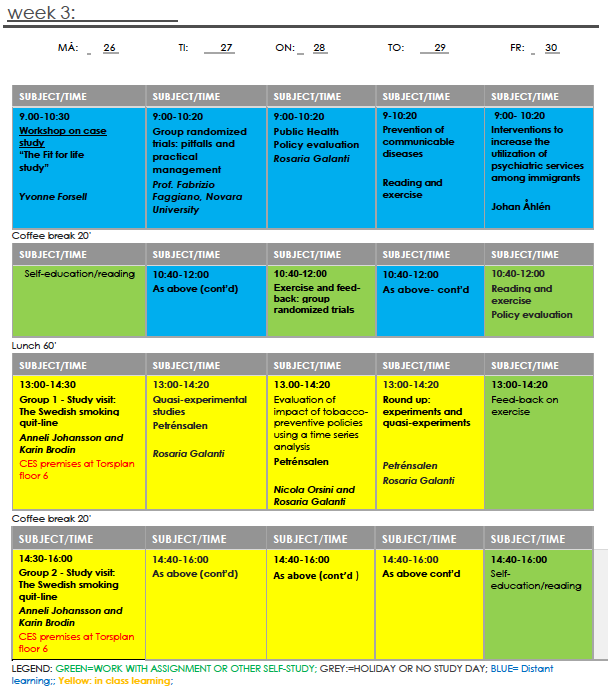
Epidemiological Methods for Outcome Evaluation of Public Health Interventions: Course Review
The primary goal of this course was to provide us with the knowledge and practical tools to evaluate complex public health interventions. This included learning about complex interventions, evaluation designs, statistical analysis, evaluation planning, economic evaluation among others. This was accomplished through a mixture of lectures, readings, class discussion, practice exercises and the final case assignment.
Course leadership
Our course director was Rosario Galanti. She facilitated the course, assignments and taught the majority of the lectures and was our point of contact if we had any questions. Throughout the course we had numerous guest lecturers, to teach about their different intervention evaluations.
Course themes
The main topics discussed:
- Week 1: Evaluation goals and defining an outcome
- Week 2: Observational and experimental studies
- Week 3: Randomized trials and quasi-experiments
- Week 4: Statistical issues, reporting, economic evaluation & planning
- Week 5: Advantages and disadvantages of designs
- Week 6: Examination task
- Week 7: Examination task and oral exam
Time structure
This was a seven-week course. Lectures were not compulsory (except for the first-day and mid-course roll call), but highly advised. Most days we had lectures from 9:00 a.m. – 4:00 p.m., interspersed with time for practice exercises and individual reading. Otherwise, our schedule varied due to the COVID hybrid learning and was split between campus classes, zoom classes, group work and individual learning time.

Assignments
Throughout the course, we were provided with unmarked practice exercises and were provided with feedback. Our only grade from this course was from the final written and oral exam.
Exam
We did not have a final exam in this course, rather we had an individual take-home exam. For the exam, we each were randomly assigned 1 out of 8 case studies. Each case study was a public health intervention, and we had to integrate the various concepts we had learned throughout the course to create our own evaluation protocol. We could collaborate with our classmates who had the same case study, however, have individual submissions. This was followed by an oral presentation/examination of our case study. We had to be able to explain and justify why we selected this evaluation design.
The exam’s grading criteria was fail <50%, pass > 50% and pass with distinction >83% (with no question with 0).
Pros/Cons
In my opinion, the benefits of this course were that we learned the practical skills involved with a public health intervention evaluation, which is something we actually will have to do whether you pursue further academics or in the workforce. For the examination, all of the case studies were real-life examples of public health interventions and it was one of the first courses that we got to apply our new knowledge to a setting outside of research and I appreciate that.
For me, the main con was that the course content and lectures overlapped with many of our previous courses, so it felt a bit repetitive. However, the final assignment did pull it all together and we were able to apply these concepts to a new context.
Overall, this course was very practical and I feel confident in my abilities to evaluate a public health intervention.
Thanks for reading and let me know if you have any questions!
Lauren
Lauren Wiebe- Health Promotion and Prevention
Hi! I am Lauren, I was born and raised in Canada, and you probably will hear me talking about how much I love Canada, especially the mountains. I am the blogger for the Master's Public Health Sciences Health Promotion and Prevention stream and I am excited to share my experiences with you!

0 comments